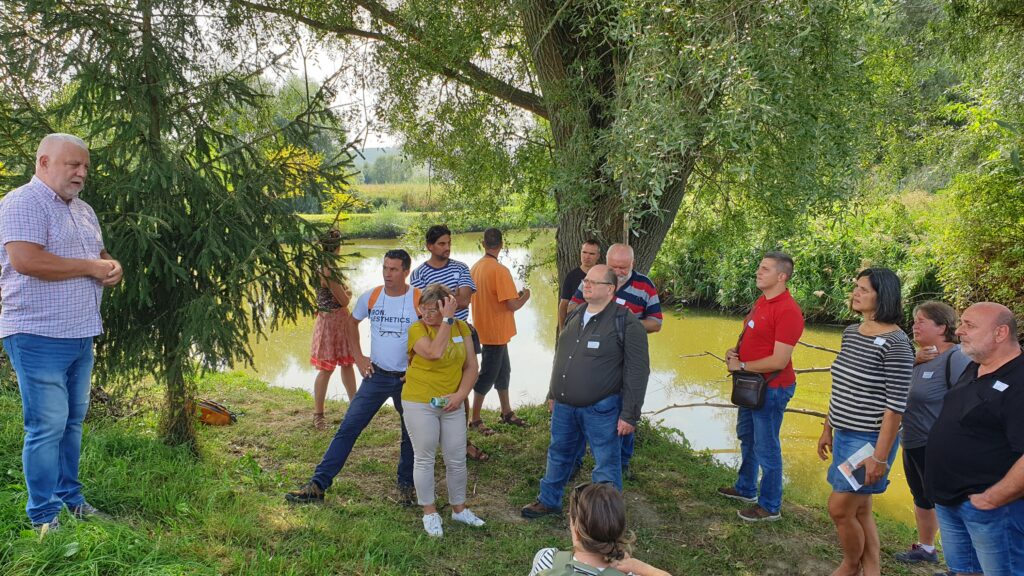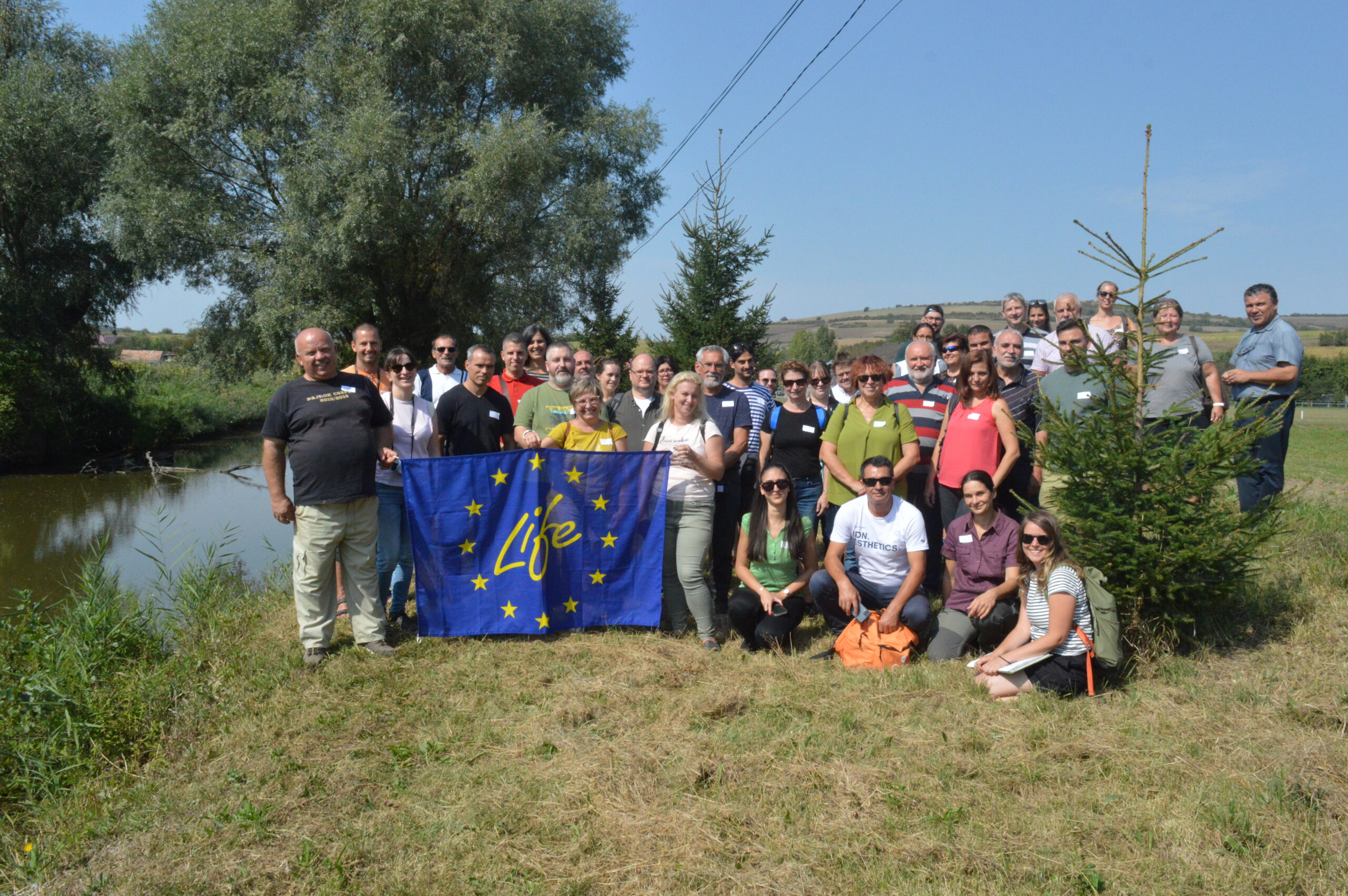In mid-September, the 3rd international study trip in the framework of the LIFE LOGOS 4 WATERS project took place in a group of small Hungarian settlements along the tributary of the Mures River in Transylvania, with nearly 40 participants – heads of municipalities, water management, spatial planning and landscape architecture experts. The aim of the study tour was to learn about the water management problems in the Niraj river basin and about small-scale solutions to alleviate these problems, which have been implemented in recent years and which could serve as a model for similar problems in Hungary.

Location of the Niraj River in the network of watercourses (Figure: Zoltán Hajdu PhD)
The catchment area of the Niraj River is about 625 km2, with an average flow of 3.6 m3 per second, but its flood flow can be up to 90 times higher during floods. From the 16th century onwards, the middle reaches of the river were used for the so-called floodplain-farming, similar to that of the Tisza floodplain, and the excellent soil in this area has given rise to rich fruit and vegetable production. The river was later heavily regulated, a process that continues to this day. The works have led to the emergence of problems that are also typical of our country, such as the incision of the riverbed and the drying out of the river valley, or the lowering of the water table. The latter is a particular problem in the Transylvanian countryside visited, where water supply for people and animals are provided by wells, which are located in every house in the settlements of the small valley, where there is neither a piped water network nor abundant deep ground water resources.

Watering pond on the border of Székelytompa and Nirajszereda: the only supply is the retention of rainfall that runs off from the hills, while the reedbeds ensure good water quality (Photo: Klára Kerpely, WWF)
Our hosts also showed us the huge emergency reservoir dam built by the Romanian Water Directorate to protect the settlements along the Niraj River from flooding. They were proud to report that, thanks to the cooperation between the municipalities, the former river bend cut off during the river regulation process (an oxbow) was not filled in at the same time as the dam was built, but remained as a wetland on the outskirts of Jobbágyfalva.


The dam of the Jobbágyfalva reservoir, with the floodplain forest above the dam, and the rescued meander (Photo: Klára Kerpely, WWF)
The area is quite rich in oxbows, several of which were visited by the group. In addition to the previous one, the history of another backwater has been extremely interesting: in Nirajgálfalva, the Niraj River has already incised its bed several metres deeper than the level of its previously cut-off meander, so the former river bend cannot receive any water from the river. On the initiative of the local mayor, with the help of local fishermen and farmers, the dead branch has been connected to streams coming from the nearby hills and flowing into the river, thus solving the problem of water supply to the oxbow lake. According to the locals, the restoration of the meander has brought water back to the nearby wells, and there have been many occasions when the water from the more distant wells in the village disappeared so the inhabitants could replenish their needs only from here. In this respect, water conservation has been successful in the area.

Mayor Károly Karácsony talks to visitors from Hungary at the rehabilitated oxbow, which is also used as a recreational and fishing lake (Photo: Klára Kerpely, WWF)
The smallest and “most nature-based” water retention solutions were created fifteen years ago on the Dormán stream, a tributary to the Niraj, with the help of students from Cluj-Napoca. Using locally sourced logs, they built 30-40 cm high beaver dam analogues on the stream in Kisadorján and Nagyadorján, which, in addition to slowing the stream’s drying during the summer contribute to the physical diversity of the stream bed and thus to habitat enrichment.

With Zoltán Hajdu PhD at the Dormán stream: the sediment trap and habitat creation function of the fifteen years old bottom sill is still in operation (Photo: Zsuzsa Dávid, WWF)
The mayors from different parts of Hungary were often familiar with the stories of their Transylvanian colleagues on the successes they have achieved despite the difficulties, as people in Hungary – especially those living in the hilly areas – are struggling with the same extreme phenomena (drought, flooding, erosion, water pollution). The main lessons learned from the study trip are that low-cost wetland rehabilitation and the creation of natural buffer zones can make a big difference in addressing these problems. However, achieving results requires leadership, broad collaboration, sound professional knowledge and endless perseverance.
We hope that by learning from good examples and exchanging experience abroad, we can help strengthen cooperation between stakeholders at home and enhance awareness of natural water retention measures.
Representatives of the following organisations took part in the study tour organised in the framework of the LIFE LOGOS 4 WATERS project:
- Ministry of Agriculture, Department of Nature Conservation
- Lower Danube Valley Water Directorate
- Bács-Kiskun County Government Office/Department of Environmental Protection, Nature Conservation and Waste Management
- Municipality of Bátya
- Ministry of the Interior Municipal Coordination Office
- Ministry of Interior Deputy state Secretariat for Water and Public Works
- Csömör Municipal Services Nonprofit Ltd.
- Municipality of Drágszél
- Municipality of Dusnok
- Municipality of Galgagyörk
- Municipality of Hosszúhetény
- Municipality of Kisnémedi
- Association of Climate Friendly Municipalities
- Central Danube Valley Water Directorate
- Hungarian Agricultural and Life Sciences University (MATE)
- Hungarian Chamber of Engineers, Water Management Section
- Association of Hungarian Landscape Architects
- Prime Minister’s Office, KEHOP MO
- National Chamber of Agriculture
- National University of Public Service, Faculty of Water Sciences
- General Directorate for Water Management
- Municipality of Penc
- Pest County Government Office/Environmental Protection, Nature Conservation and Waste Management Department
- Municipality of Pomáz
- Municipality of Püspökhatvan
- Municipality of Püspökszilágy
- Municipality of Szokolya
- Municipality of Vácduka
- Foundation for Vácduka
- Municipality of Váckisújfalu
- WWF Hungary
More information on water management in the Niraj Valley and the solutions implemented in the region can be found at the following links:
- Video: A víz titkai (Misterele apei)
- Erasmus+ NABI Nature-Based Innovation for Urban Forest and Rainwater Management: A ZÖLDFELÜLET GAZDÁLKODÁS ÉS A CSAPADÉKVÍZHASZNOSÍTÁS EURÓPAI JÓ GYAKORLATAI 2021. (from page 75.)
- Hajdu Zoltán – Tervezés, újratervezés. Marosvásárhely, 2020. (from page 41.)
- Blog on the Niraj regulation: https://regularizare.wordpress.com/
- Mennyit érnek a természet ajándékai? Summary study of the ecosystem service research of the Niraj and Kis-Küküllő Natura 2000 sites (Arany, 2017)
By Klára Kerpely, WWF Hungary Foundation




















